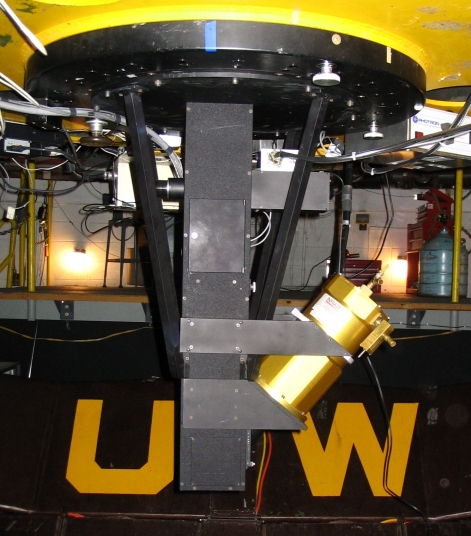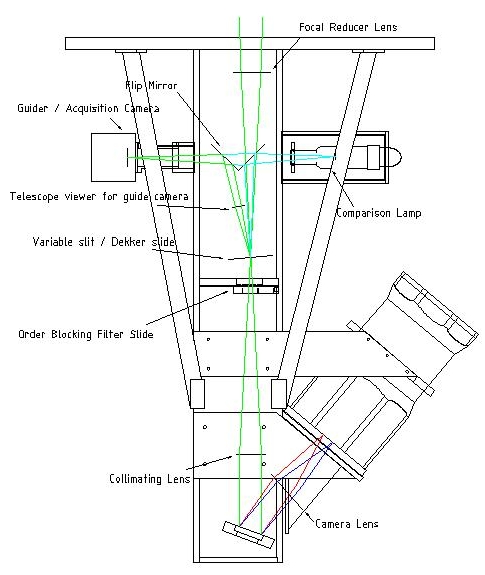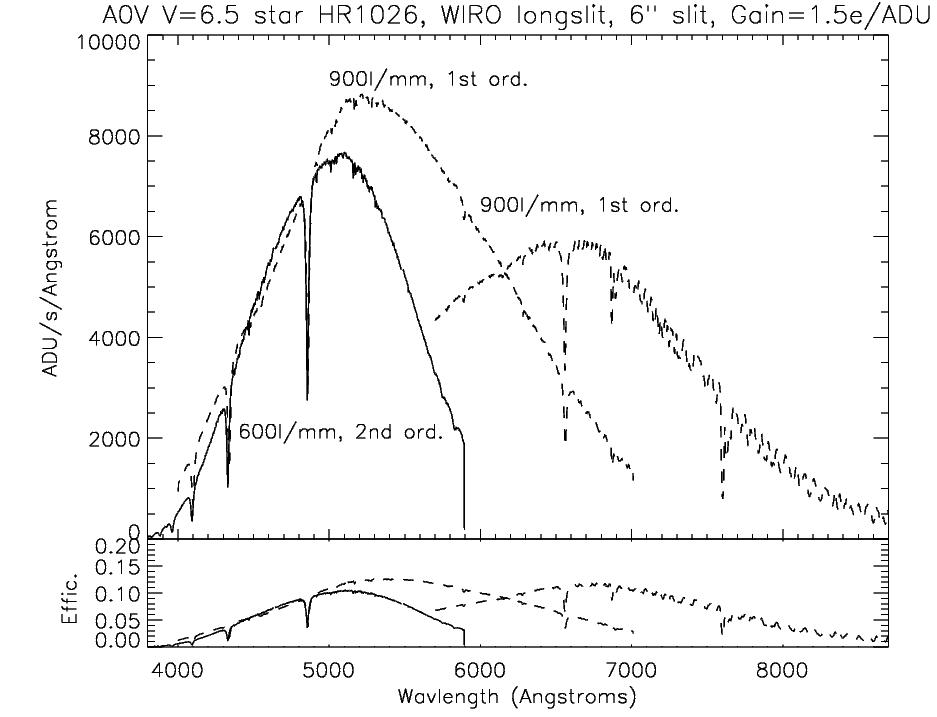

WIRO Long Slit Spectrograph
CuAr Atlas available here
Instrument pictures here
Instrument electronics here
The long slit spectrograph is the third of a new generation of instruments built for the Wyoming Infrared Observatory (WIRO). The spectrograph was designed by Michael Pierce and Andy Monson from an existing surplus spectrograph. Parts and machining were provided by Steve Hodder and the A&S Machine Shop. James Weger developed the electrical aspects of the spectrograph which was a great contribution since the obsolete version had no existing electrical components. The main goal of the instrument was to provide low resolution high efficiency spectroscopy for faint targets such as AGN and also to provide fast simple reduction for a number of targets such as stars, where multiple targets can be observed in a relatively short amount of time. The long slit spectrograph is mounted at cassegrain focus (see figure to right) and uses the same Marconi detector housed in a IR-Labs dewar which is also used in the WIRO-Spec and WIRO-Prime instruments. The nominal position angle for the instrument is 0 degrees, however, it is mounted on an instrument rotator and can achieve any desired position angle on the sky (manually). A PHOTRON CuAr lamp is housed in the spectrograph to provide wavelength calibration. An SBIG-ST-2000 camera is used for object acquisition and guiding (25″ field). This camera can also be used for imaging (65″ field) in UBVR, Halpha filters via an attached filter wheel. Several gratings are available which can be swapped through an access port on the spectrograph. One of the gratings operates in second order so an order separation filter can be placed in the system to eliminate first order contamination. The slit assembly consists of a variable slit and dekker slide which can be manually adjusted for desired performance.
Optical Design

The long slit spectrograph is mounted to the rear cell of the telescope at cassegrain focus. Currently the secondary mirror produces an f/27 beam. The long slit spectrograph has a focal reducer at the front end to change the incoming beam to f/9. A flip mirror, which is controlled by the user interface with a compumotor, allows the beam to be directed to a CCD camera for imaging of the target field or to the slit assembly. The slit assembly is comprised of a slit dekker which contains multiple masks and a variable slit. A filter slide with different options is available for order blocking depending on the grating and target wavelengths. A collimating lens produces a collimated beam before hitting the grating. The light is imaged onto the focal plane of the Goldmember dewar using a Cooke lens.
Light that is reflected of the slit is sent of axis to an imaging lens (small telescope) off a flip mirror and imaged on the guider focal plane. The flip mirror can be switched which allows for direct imageing of the target field while allowing for comparisons to be taken.
Mechanical Design
The spectrograph mounts to the rear cell of the telescope on the instrument rotator with 12 3/8? 16tpi socket head machine screws. All edges and joints are recessed to allow for a light tight package. There are four support struts which allow for greater flexure control. The dewar mounts to a machined smooth surface and is supported by support struts attached to an alignment collar permanently fixed to the dewar.
The CuAr comparison lamp is mounted in a simple light tight box and is supported with plexi-glass and set screws to keep its position fixed. A diffuser is mounted at the hole entering the spectrograph to allow the comparison light to fully illuminate (evenly) the entire slit.
The guider hear has an 1.25? nose piece that is held to a brass tube with set screws. The brass tube is threaded and can be adjusted to place the guider at the appropriate position and can be locked in place with the locking ring.
The flip mirror is controlled with a compumotor and there are switched that are activated when the mirror is in one of the two positions. The mirror is held firm against a block on either side by a magnet.
There is an access hatch to allow users to set the slit width and dekker position. The slit widens on either side so the center of the slit is fixed. The micrometer that controls the slit width is in units of 1000th’s of an inch so the scale at the slit is 0.250arcseconds per 1000th (a setting of 10 is 2.5 arcseconds wide).
The order blocking slide is manually controlled with a silver push/pull lever. There are switches that activate when the slide is in a certain position. The switches are constantly read by the long_slit software so if the user should happen to move it, it will show up on the computer interface.
The grating is housed in a custom mount that can be removed from the spectrograph through another access port. The grating mount is attached to the spectrograph through a hole on the backside, a washer and threaded shaft from the outside then serve to lock the mount to the inside. To adjust the grating tilt, the locking screw needs to be loosened and a micrometer on the side of the spectrograph can be used to adjust the tilt of the grating, then the locking screw can be re-tightened. NOTE: the micrometer has a backlash of 4microns when changing directions.
The Cooke camera lens (focal length ~106 mm, empirically determined) that is used for imaging the spectra is inside a barrel that juts to the side. The lens is mounted in a threaded assembly that allows the user to adjust the focus manually from outside. The focus mechanism is recessed to prevent accidental adjustment and it is resistant against change. Once set, the camera focus should remain nearly constant and the need to adjust should be minimal.
Consult the WIRO Operations manual under the section on the Longslit Spectrograph for a list of gratings and resolutions. A portion is reproduced here.
| Grating | Disp.(A/pix) | Fiducial | Grating Tilt(micrometer) | CameraFocus | Coverage(Ang) | Filter | Flats(at 90 on rheostat) |
| 2000 l/mm grating | 0.65 | 258-280286 @50F | 5350-6650 | none | 150s | ||
| 1800 l/mm 5000blaze | 0.72 | Ha@pix 300 | ~55 deg0.250 | 300 (2011June01) | 5350-6770(don’t use in blue; Woods anomaly) | GG455 or unfilt | 180s |
| 600 l/mm, 2nd order | 1.12 | Hb@pix 1020 | 0.05 | 310 (2011Jun02) | 4000 5900 | BG40 | 150s |
| 1500 l/mm holographic | 0.89 | Ha@pix 620 | 285? | 5300 7100 | GG455 | 120s | |
| 900 l/mm 1st order | 1.49 | Ha @pix300 | 0.14 | 310 | 4000 7000 | none | 120s |
| 900 l/mm 1st order | 1.49 | Ha @pix1450 | 0.03 | 315 (2011Jul22)335ish (old) | 5800 8700 | GG455 | 15s |
| 900 l/mm 1st order | 1.49 | Ha @pix200 | -0.02 | 375 (2011JSep08)hard to focus | 6400 9300 | GG455 | 20-40 |
Sensitivity
Spectroscopy on targets brighter than about V=15 is feasible in reasonable integration times. Fainter targets may be possible in excellent conditions albeit with low S/N. The following plot shows count rates in ADU per second for a V=6.5 mag. A0V star (HR1026) and total system efficiency assuming a gain of 1.5 e/ADU for two common grating setups. The total efficiency involves losses for atmosphere, detector, mirrors and glasses in the 3 lenses, and a small amount of slit loss.

Order Separation Filters
The use of order separation filters is to prevent 1st order light from contaminating the 2nd order. Of course, this is not a problem if using a grating blazed for 1st order?in that case the goal is to prevent 2nd order light from contaminating the 1st. There are three available filters: BG40, KG3, GG455 (yellow glass, says 463 on edge) although any 1? circular filter will fit in the slide. The BG40 will work well for any situation where you want to observe from ~350 nm to 600nm. Although since the instrument is not very UV sensitive you won’t get much at the blue end, also the BG40 starts cutting-off steeply near 600 nm so H-alpha would be faint. The KG3 filter is wider however, if you want to work in the 400-800 nm range in 1st or 2nd it will be fine (remember the instrument wont let much light through before 400nm). Unfortunately, the KG3 does allow some leaks, but if you are observing far from the overlap, it won’t matter. GG455 is used in conjunction with the 1800l/mm grating to prevent 2nd order contamination when working at red wavlengths longer than about 700 nm.

Guider

The current guider in use is the SBIG ST-2000. When used in the slit viewing mode the camera has a field of view of approximately 25 arcseconds. Nominally the instrument is mounted at a position angle of zero degrees, in which case the slit runs North-South. The instrument can be rotated +/- 90 degrees. The dome flat screen allows for taking flat frames to get the illumination along the slit. Exposure times will vary on the intensity of the flat lamps and on the slit width and if a filter is being used. A typical situation is with a slit width of 2.5arcseconds with a filter (~90% throughput) and the lamps at 120V in which case an exposure of 180s yields ~25,000 counts.
- Longslit Interface
The Longslit interface controls one stepper motor on the long slit spectrograph with …. to be written
Sample Spectra


